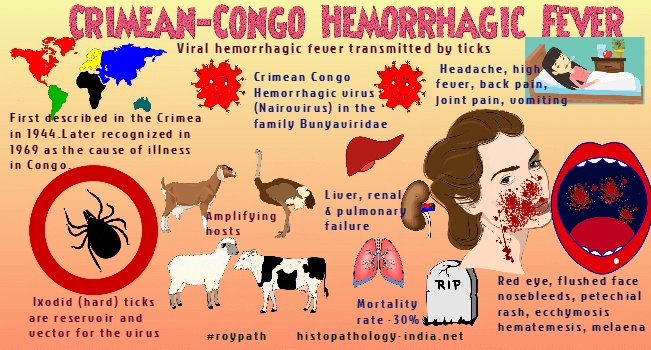|

Custom Search
|
|
Infectious Disease Online Pathology of Crimean-Congo Hemorrhagic Fever
|

|
Crimean-Congo hemorrhagic fever (CCHF) is a tick-borne disease caused by the arbovirus Crimean-Congo hemorrhagic fever virus (CCHFV), which is a member of the Nairovirus genus (family Bunyaviridae). Crimean-Congo hemorrhagic fever (CCHF) is a severe zoonotic disease which affects people coming into contact with livestock or ticks. It may also be transmitted through person-to-person transmission by exposure to infected body fluids. The genus Hyalomma of ixodid ticks is the most important vector of the CCHF virus. Vertebrates including birds and small animals provide excellent amplifier hosts of both the virus and the tick. It was originally reported among farm workers in Crimea, USSR (1944), and recurs annually in a wide belt across Africa, in the eastern Balkan States, and in the Soviet Central Asian republics bordering the shores of the Black and Caspian Seas.The range of the CCHF virus is now known to extend from central Asia to India, Pakistan, Afghanistan, Iran, Iraq, the Middle East, Eastern Europe, and to most of Saharan and sub-Saharan Africa. After an incubation period of approximately 3 to 6 days the abrupt onset of acute febrile illness occurs. The first symptoms are similar to severe influenza and include fever, headache, severe back and abdominal pain. The hemorrhagic fever manifestations occur after several days of illnesses and include petechial rash, ecchymoses, hematemesis, and melaena. It is accompanied by pneumonitis, pulmonary hemorrhages, and edema and hemorrhages in mucous membrane and the genitourinary and gastrointestinal tracts. Cases typically present with some form of hepatitis. The mortality rate is 10-50% in different outbreaks with deaths typically occurring during the second week of illness. Animal reservoirs are small wild mammals (especially rodents), domesticated animals (sheep, cattle, goats, and hares), and birds.Early diagnosis is possible in special laboratories using antigen detection by imunofluorescence or ELISA tests or molecular methods as PCR and antibody detection. Tick control measures need to be emphasized and utilized to prevent CCHF. This includes spraying camp sites, clothing and danger areas with acaricides or repellent. Strict isolation of patients with CCHF and a focus on barrier nursing would help to prevent nosocomial spread. |
|
|

